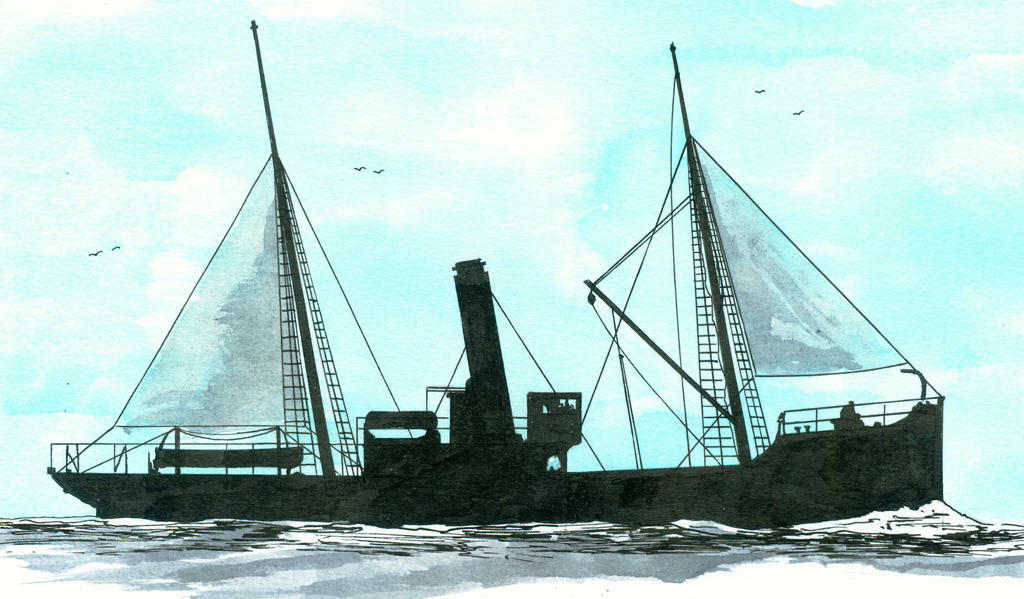The tender for building was dated 18 September 1901 and the 28th was she ordered by the Department of navy subdepartment pilotage. Her keel was laid down on 26 March a year later with yard number 99, in the thrushes on 12 April, plating fitted on 30 May, launched on 5 July, engines tested while anchored on 9-12 September, technical trial on 6 October, official trial on 21 October and transferred on 14 November when she departed towards Rotterdam with as captain Pronk. On 2 May 1918 while used as a minesweeper near the Stortemelk, Terschelling struck she amidships a mine and exploded causing the death of ten men.(1) She was built in 13,5 months with working weeks of 66 hours with as shipbuilder jr.J. Janszen jr. The contracted price was totally ƒ 118.000 ƒ 71.700,0 for the ship, ƒ 33.000 for the engine and boiler and ƒ 13.000 profit. The real expenses were for the ship totally 74.723,- consisting of wages ƒ 21.504,0, expenses 13.330,0, dry dock ƒ 86,0, stores ƒ 29.654,-, inventory ƒ 6.326,0 and cash ƒ 3.823,-. For the engine ƒ 30.065,- and for the boiler ƒ 8.454,-. Cost price without profit ƒ 113.245,-. One triple compound 3-cylindersteam engine of 300 (contract)-343 ihp allowing with 141 rpm a trial speed of 10,51 knots. One boiler. One funnel. One screw. Coal bunker capacity 28,5 ton. Fresh water capacity 0,5 ton. Two masts. Completely steel-built and an upper deck of teak wood. Displacement 105 (launching)-232 tons and as dimensions 31,10 (between perpendiculars)-32,94 (over all) x 6,50 x 1,35 (fore launching)-1,65 (aft launching)-2,45 (middle in service) and 3,35 (hold) metres or 102’0”-108’1” x 21’4”x 8’0½”and 11’0”. One steam winch. Her crew numbered 11 men.
The newspaper De Zeeuw dated 31 December 1901 reported that she was to be named Frans Naerebout. She was called a steam pilot transport schooner. The newspaper Middelburgsche Courant dated Monday the 7th reported her launching at the Saturday the 5th at 12.00 o’clock. Her keel was laid down at 26 March. The engine and boiler were still to be placed inside her. Two days later reported the newspaper Vlissingse Courant that her trial at the roads were successful. The newspaper De Zeeuw dated 15 November reported her arrival at Flushing and that she the next day would depart for Rotterdam where she was to be stationed.
Source
Order administration shipyard Kon.Mij. De Schelde, Flushing, Netherlands (Municipality Archive Flushing)
Note
1. The Dutch newspaper Algemeen Handelsblad dated 3 May 1918 described her loss due to a mine-explosion. Five of her crewmembers were directly killed and five missing. Eight crewmembers included a passenger (a navy officer) were saved. The naval vessels Noordsvaarder and Lutine assisted by the rescue. Saved were lieutenant Van Waasdijk, senior skipper Gayaard, H. Hablus, Van Dorst, De Wijn, Rechtsteiner, Aluds, Bakker and Vervark. Killed were M. Hoek, J. Schenk, G.J. Haavekost, M. Erkelens and J.G. Verharen and missing J.W.F. Ridderikhof, R. Broer, P.J. Kortlebess, A. Arend and P.W. Grootveld. A short time ago was all most on the same spot the Dutch torpedo boat Hr.Ms. G11 lost also due to striking a mine.

